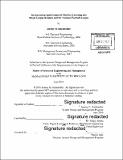| dc.contributor.advisor | Sanjay Sarma. | en_US |
| dc.contributor.author | Hochstedler, Jeremy H | en_US |
| dc.contributor.other | Massachusetts Institute of Technology. Engineering Systems Division. | en_US |
| dc.date.accessioned | 2017-12-05T19:13:24Z | |
| dc.date.available | 2017-12-05T19:13:24Z | |
| dc.date.copyright | 2016 | en_US |
| dc.date.issued | 2016 | en_US |
| dc.identifier.uri | http://hdl.handle.net/1721.1/112451 | |
| dc.description | Thesis: S.M. in Engineering and Management, Massachusetts Institute of Technology, School of Engineering, System Design and Management Program, Engineering and Management Program, 2016. | en_US |
| dc.description | Cataloged from PDF version of thesis. | en_US |
| dc.description | Includes bibliographical references (pages 53-54). | en_US |
| dc.description.abstract | Rich data sets exist in Major League Baseball (MLB) and the National Football League (NFL) that track players and equipment (i.e. the ball) in space and time. Using machine learning and other analytical techniques, this research explores the various data sets in each sport, providing advanced insights for team decision makers. Additionally, a framework will be presented on how the results can impact organizational decision-making. Qualitative research methods (e.g. interviews with front office personnel) are used to provide the analysis with both context and breadth; whereas various quantitative analyses supply depth to the research. For example, the reader will be exposed to mathematical/computer science terms such as Kohonen Networks and Voronoi Tessellations. However, they are presented with great care to simplify the concepts, allowing an understanding for most readers. As this research is jointly supported by the engineering and management schools, certain topics are kept at a higher level for readability. For any questions, contact the author for further discussion. Part I will address the distinction between performance and production, followed briefly by a decomposition of a typical MLB organizational structure, and finally display how the results of this analyses can directly impact areas such as player evaluation, advance scouting, and in-game strategy. Part II will similarly present how machine learning analyses can impact opponent scouting and personnel evaluation in the NFL. | en_US |
| dc.description.statementofresponsibility | by Jeremy H. Hochstedler. | en_US |
| dc.format.extent | 55 pages | en_US |
| dc.language.iso | eng | en_US |
| dc.publisher | Massachusetts Institute of Technology | en_US |
| dc.rights | MIT theses are protected by copyright. They may be viewed, downloaded, or printed from this source but further reproduction or distribution in any format is prohibited without written permission. | en_US |
| dc.rights.uri | http://dspace.mit.edu/handle/1721.1/7582 | en_US |
| dc.subject | Engineering and Management Program. | en_US |
| dc.subject | System Design and Management Program. | en_US |
| dc.subject | Engineering Systems Division. | en_US |
| dc.title | Incorporating spatiotemporal machine learning into Major League Baseball and the National Football League | en_US |
| dc.title.alternative | Incorporating spatiotemporal machine learning into MLB and the NFL | en_US |
| dc.type | Thesis | en_US |
| dc.description.degree | S.M. in Engineering and Management | en_US |
| dc.contributor.department | Massachusetts Institute of Technology. Engineering and Management Program | en_US |
| dc.contributor.department | System Design and Management Program. | en_US |
| dc.identifier.oclc | 1010498453 | en_US |
